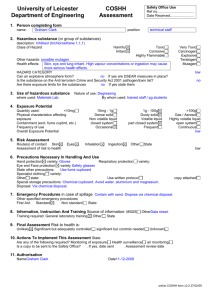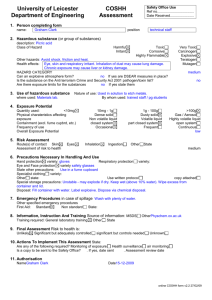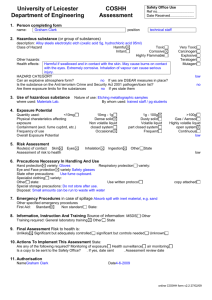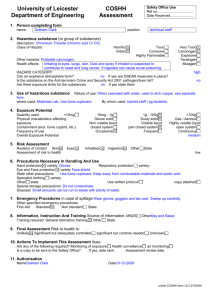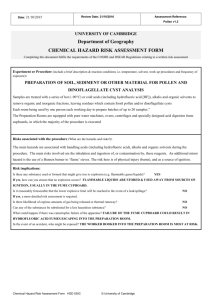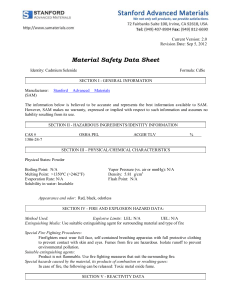Preparation of samples for particle size analysis on the Malvern
advertisement
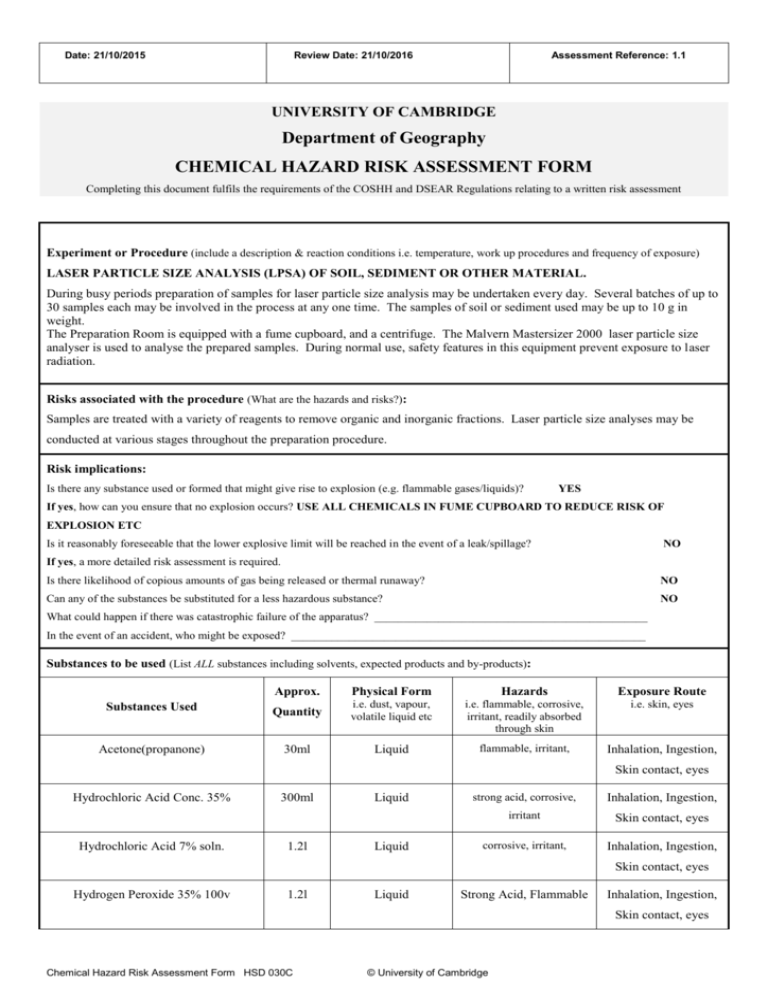
Date: 21/10/2015 Review Date: 21/10/2016 Assessment Reference: 1.1 UNIVERSITY OF CAMBRIDGE Department of Geography CHEMICAL HAZARD RISK ASSESSMENT FORM Completing this document fulfils the requirements of the COSHH and DSEAR Regulations relating to a written risk assessment Experiment or Procedure (include a description & reaction conditions i.e. temperature, work up procedures and frequency of exposure) LASER PARTICLE SIZE ANALYSIS (LPSA) OF SOIL, SEDIMENT OR OTHER MATERIAL. During busy periods preparation of samples for laser particle size analysis may be undertaken every day. Several batches of up to 30 samples each may be involved in the process at any one time. The samples of soil or sediment used may be up to 10 g in weight. The Preparation Room is equipped with a fume cupboard, and a centrifuge. The Malvern Mastersizer 2000 laser particle size analyser is used to analyse the prepared samples. During normal use, safety features in this equipment prevent exposure to laser radiation. Risks associated with the procedure (What are the hazards and risks?): Samples are treated with a variety of reagents to remove organic and inorganic fractions. Laser particle size analyses may be conducted at various stages throughout the preparation procedure. Risk implications: Is there any substance used or formed that might give rise to explosion (e.g. flammable gases/liquids)? YES If yes, how can you ensure that no explosion occurs? USE ALL CHEMICALS IN FUME CUPBOARD TO REDUCE RISK OF EXPLOSION ETC Is it reasonably foreseeable that the lower explosive limit will be reached in the event of a leak/spillage? NO If yes, a more detailed risk assessment is required. Is there likelihood of copious amounts of gas being released or thermal runaway? NO Can any of the substances be substituted for a less hazardous substance? NO What could happen if there was catastrophic failure of the apparatus? _______________________________________________ In the event of an accident, who might be exposed? _____________________________________________________________ Substances to be used (List ALL substances including solvents, expected products and by-products): Approx. Physical Form Hazards Exposure Route Substances Used Quantity i.e. dust, vapour, volatile liquid etc i.e. flammable, corrosive, irritant, readily absorbed through skin i.e. skin, eyes Acetone(propanone) 30ml Liquid flammable, irritant, Inhalation, Ingestion, Skin contact, eyes Hydrochloric Acid Conc. 35% Hydrochloric Acid 7% soln. 300ml 1.2l Liquid Liquid strong acid, corrosive, Inhalation, Ingestion, irritant Skin contact, eyes corrosive, irritant, Inhalation, Ingestion, Skin contact, eyes Hydrogen Peroxide 35% 100v 1.2l Liquid Strong Acid, Flammable Inhalation, Ingestion, Skin contact, eyes Chemical Hazard Risk Assessment Form HSD 030C © University of Cambridge Sodium Pyrophosphate 4.4% soln. 1.2l Liquid Irritant Inhalation, Ingestion, Skin contact, eyes Ethanol 2.5L Liquid Corrosive, Irritant Are any of the substances listed above R42, R43, R45, R46, R49, R60, R61, R64? Ingestion, Skin, eyes NO (If yes, contact Occupational Health and refer where necessary to the University Code of Practice on the Safe Use of Carcinogens etc) Control measures to be used (continue on a separate sheet if necessary): Containment: Personal Protective Equipment: Fume cupboard YES Lab coat / overalls YES Glove box / isolator NO Chemical apron YES Safety cabinet NO Gloves YES Local exhaust ventilation YES Eye Protection YES Respiratory protective equipment NO Other (specify) Other (specify) Are any additional controls required? (Consider nearby sources of ignition, formation of explosive atmospheres/mixtures, asphyxiation in confined spaces) Lab coat, gloves and eye protection are the minimum required personal protection for all reagent use. In addition, nitrile gloves and a protective apron are required for handling concentrated acids. Disposal measures to be used during and after the procedure: (Also consider by-products and washings) All reagents to be disposed of via the fume cupboard sink which is connected to a sump filled by marble chips. This neutralises all acidic waste products. Sediment contained in Sediment trap, this is then disposed of by laboratory staff in to a bin Emergency Procedures (emphasise any special hazards): Shutdown Procedures: In an emergency, close the fume cupboard sash fully, vacate the preparation room and summon help Action in the event of fire (type of fire extinguisher):Powder Action in the event of spillage or uncontrolled release: don’t panic. small spills in the fume cupboard can be safely contained with saturated sodium carbonate solution. larger spills outside the fume cupboard may be controlled with a spill containment pack and/or slaked lime. if in doubt, vacate the preparation room and summon help. if fume escape or inhalation is suspected, vacate the preparation room and summon help. Emergency treatment for personnel in the event of contamination, exposure to fumes or other adverse effects Eyes: Irrigate with cool clean water for at least 20 minutes, summon first aid, if needed send to A & E unit in Hospital. Skin: Remove contaminated clothing and flood skin with cool clean water and summon first aid. Inhalation: Remove casualty to fresh air, summon first aid and if needed send to A & E Unit at Addenbrookes Hospital. Name of assessor: Signature: Date: Name of co-signatory: (e.g. Supervisor / authorised deputy) Signature: Chemical Hazard Risk Assessment Form HSD 030C Date: © University of Cambridge

